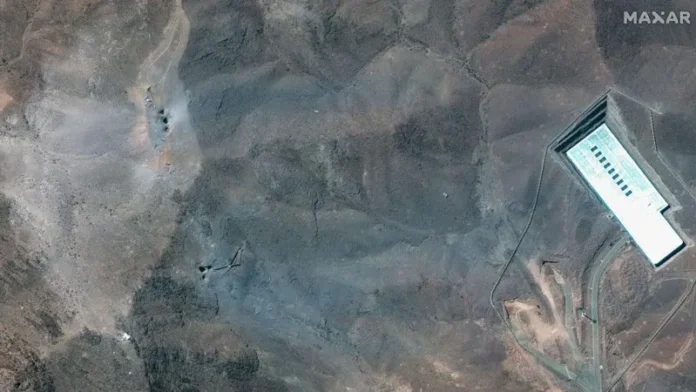WASHINGTON/TEHRAN – The United States’ recent airstrikes on Iran’s nuclear facilities have failed to eliminate the Islamic Republic’s nuclear programme entirely, likely setting it back only by a matter of months, according to an early intelligence assessment by the Pentagon, as reported by CBS News.
The strikes, which took place on Saturday, were initially hailed by the White House and top defence officials as a resounding success.
However, internal evaluations from the Defense Intelligence Agency (DIA) now suggest a more modest impact, raising questions about the true effectiveness of the military campaign and the political messaging surrounding it.
According to sources familiar with the DIA’s assessment, the strikes did not succeed in destroying Iran’s enriched uranium stockpile, a critical component of any potential nuclear weapon.
“The materials had already been taken out,” claimed Hassan Abedini, deputy political director at Iran’s state broadcaster, suggesting that Tehran anticipated the attack and moved sensitive resources in advance.
Conflicting Assessments
The White House has strongly pushed back against the emerging intelligence narrative. A spokesperson described the leaked assessment as coming from “a low-level loser in the intelligence community” and insisted that the strikes represented “one of the most successful military strikes in history.”
President Donald Trump doubled down on that sentiment in a press briefing, stating: “Iran’s nuclear sites were completely destroyed. What we did was historic.”
He accused media outlets and political opponents of trying to undermine the administration’s achievements. Meanwhile, General Dan Caine, chairman of the Joint Chiefs of Staff, offered a more cautious tone.
While emphasizing that all three targeted nuclear sites—Natanz, Fordo, and Isfahan—sustained “extremely severe damage and destruction,” he admitted that the full extent of the impact, particularly on subterranean structures, remains unclear.
Recent satellite imagery showed six craters clustered around two access points at the Fordo facility, alongside visible dust and debris.
However, analysts caution that such surface-level assessments are inadequate in evaluating damage to the underground centrifuge halls where uranium enrichment typically occurs.
Iran Claims Minimal Losses
From Tehran, Iranian officials sought to downplay the impact of the strikes. Abedini told state media that the sites had been evacuated “a while ago,” and reiterated that the country “didn’t suffer a major blow.”
Iran’s rapid retaliatory missile strike on the Al-Udeid Air Base in Qatar—home to thousands of U.S. military personnel—further signalled that Tehran retained significant offensive capabilities. While the missiles were largely intercepted, the move underscored Iran’s willingness to escalate tensions.
A ceasefire, brokered in the aftermath by President Trump with mediation from Qatar, is currently holding.
Political Fallout and Unanswered Questions
The contrasting narratives coming out of Washington have drawn bipartisan scrutiny. Democratic Congressman Brad Sherman, a senior member of the House Foreign Affairs Committee, criticized the administration’s ambiguous language.
“They haven’t said whether the strikes destroyed Iran’s ability to weaponize its uranium, or whether they destroyed its stockpile or the centrifuges used to enrich uranium,” Sherman said in an interview with the BBC.
Sherman also referenced reports of truck movements at nuclear facilities in the days leading up to the strike, suggesting that Iran may have relocated critical assets. “All indications, including Vice-President Vance’s statement, indicate that we don’t think we got the stockpile,” he added.
David Albright, president of the Institute for Science and International Security, echoed these concerns. He noted that while the strikes inflicted damage, Iran will be able to rebuild its programme—albeit with considerable effort and time.
“It will take significant investment and energy for Iran to restore its programme, but they still possess the technical expertise and institutional knowledge,” Albright said in a post on X.
Israel’s Strategic Gains
In Israel, the government has claimed a major strategic victory. Prime Minister Benjamin Netanyahu stated that the military campaign—launched after hostilities with Iran escalated on June 13—had “removed two immediate existential threats” by targeting Iran’s nuclear capabilities and missile arsenals.
“We have destroyed the threat of nuclear annihilation and that of 20,000 ballistic missiles,” Netanyahu asserted in a video message on Tuesday.
A report from Saudi news outlet Al Hadath, citing an unnamed Israeli intelligence source, claimed that much of Iran’s enriched uranium had been buried beneath the rubble of the bombed sites, lending some weight to Israel’s optimism. However, this claim remains unverified.
Intelligence Community Divided
The conflicting accounts have reignited concerns about the coherence and reliability of U.S. intelligence reporting. The United States has 18 separate intelligence agencies, often producing divergent conclusions based on varying access and analytical frameworks.
This is not the first time intelligence consensus has been elusive. The community has yet to reach a definitive conclusion on the origins of the Covid-19 virus, a situation which underscores how politicized and fractured intelligence interpretations can become.
Officials acknowledge that further assessments and on-the-ground inspections—if ever allowed—will be necessary to provide a fuller picture of the impact.
Strategic Implications
While the immediate military confrontation appears to have quieted, the strategic implications are still unfolding. Analysts say that if Iran attempts to rebuild its nuclear facilities, it risks provoking a new round of attacks from the U.S. or Israel.
Moreover, the attacks have sparked renewed debate over the utility and limits of military force in halting nuclear proliferation. Despite heavy bombardment, Iran’s technological base, scientific knowledge, and political will remain largely intact—leaving open the possibility of future nuclear capability, albeit delayed.
As tensions simmer beneath the surface, international observers are calling for renewed diplomatic engagement to avoid further escalation in an already volatile region.
This article was created using automation technology and was thoroughly edited and fact-checked by one of our editorial staff members

